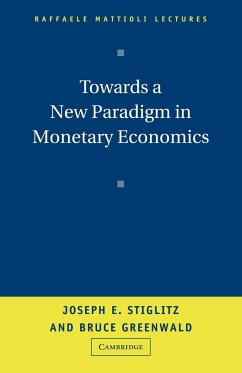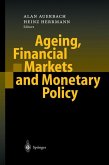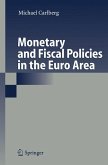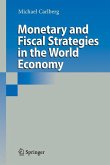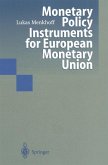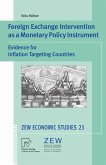- Broschiertes Buch
- Merkliste
- Auf die Merkliste
- Bewerten Bewerten
- Teilen
- Produkt teilen
- Produkterinnerung
- Produkterinnerung
bel Prize for Economics.
Andere Kunden interessierten sich auch für
![Ageing, Financial Markets and Monetary Policy Ageing, Financial Markets and Monetary Policy]() Alan Auerbach / Heinz Herrmann (eds.)Ageing, Financial Markets and Monetary Policy115,99 €
Alan Auerbach / Heinz Herrmann (eds.)Ageing, Financial Markets and Monetary Policy115,99 €![Monetary Policy in the Euro Area Monetary Policy in the Euro Area]() Otmar IssingMonetary Policy in the Euro Area42,99 €
Otmar IssingMonetary Policy in the Euro Area42,99 €![Monetary and Fiscal Policies in the Euro Area Monetary and Fiscal Policies in the Euro Area]() Michael CarlbergMonetary and Fiscal Policies in the Euro Area77,99 €
Michael CarlbergMonetary and Fiscal Policies in the Euro Area77,99 €![Monetary and Fiscal Strategies in the World Economy Monetary and Fiscal Strategies in the World Economy]() Michael CarlbergMonetary and Fiscal Strategies in the World Economy97,99 €
Michael CarlbergMonetary and Fiscal Strategies in the World Economy97,99 €![Monetary Policy Instruments for European Monetary Union Monetary Policy Instruments for European Monetary Union]() Lukas MenkhoffMonetary Policy Instruments for European Monetary Union39,99 €
Lukas MenkhoffMonetary Policy Instruments for European Monetary Union39,99 €![Foreign Exchange Intervention as a Monetary Policy Instrument Foreign Exchange Intervention as a Monetary Policy Instrument]() Felix HüfnerForeign Exchange Intervention as a Monetary Policy Instrument39,99 €
Felix HüfnerForeign Exchange Intervention as a Monetary Policy Instrument39,99 €![Policy Coordination in a Monetary Union Policy Coordination in a Monetary Union]() Michael CarlbergPolicy Coordination in a Monetary Union77,99 €
Michael CarlbergPolicy Coordination in a Monetary Union77,99 €-
-
-
Produktdetails
- Produktdetails
- Raffaele Nattioli Lectures
- Verlag: Cambridge University Press
- Seitenzahl: 344
- Erscheinungstermin: 31. Oktober 2009
- Englisch
- Abmessung: 216mm x 140mm x 21mm
- Gewicht: 490g
- ISBN-13: 9780521008051
- ISBN-10: 0521008050
- Artikelnr.: 10530036
- Herstellerkennzeichnung
- Libri GmbH
- Europaallee 1
- 36244 Bad Hersfeld
- gpsr@libri.de
- Raffaele Nattioli Lectures
- Verlag: Cambridge University Press
- Seitenzahl: 344
- Erscheinungstermin: 31. Oktober 2009
- Englisch
- Abmessung: 216mm x 140mm x 21mm
- Gewicht: 490g
- ISBN-13: 9780521008051
- ISBN-10: 0521008050
- Artikelnr.: 10530036
- Herstellerkennzeichnung
- Libri GmbH
- Europaallee 1
- 36244 Bad Hersfeld
- gpsr@libri.de
Professor of Economics, Stanford University and Senior Research Fellow of Brookings Institution. Formerly Senior Vice President and Chief Economist at World Bank.
Introduction; Part I. Theory: 1. Reflections on the current state of monetary economics; 2. How finance differs; 3. The ideal banking system; 4. Restricted banking; 5. Market equilibrium; 6. From the corn economy to the monetary economy; 7. Towards a general equilibrium theory of credit; Part II. Applications: 8. Monetary policy; 9. Regulatory policy and the new paradigm; 10. Financial market liberalization; 11. Restructuring the banking sector; 12. Regional downturns and development of monetary policy; 13. The East Asia Crisis; 14. The 1991 US recession and the recovery; 15. The new paradigm and the new economy; 16. Concluding remarks.
Introduction
Part I. Theory: 1. Reflections on the current state of monetary economics
2. How finance differs
3. The ideal banking system
4. Restricted banking
5. Market equilibrium
6. From the corn economy to the monetary economy
7. Towards a general equilibrium theory of credit
Part II. Applications: 8. Monetary policy
9. Regulatory policy and the new paradigm
10. Financial market liberalization
11. Restructuring the banking sector
12. Regional downturns and development of monetary policy
13. The East Asia Crisis
14. The 1991 US recession and the recovery
15. The new paradigm and the new economy
16. Concluding remarks.
Part I. Theory: 1. Reflections on the current state of monetary economics
2. How finance differs
3. The ideal banking system
4. Restricted banking
5. Market equilibrium
6. From the corn economy to the monetary economy
7. Towards a general equilibrium theory of credit
Part II. Applications: 8. Monetary policy
9. Regulatory policy and the new paradigm
10. Financial market liberalization
11. Restructuring the banking sector
12. Regional downturns and development of monetary policy
13. The East Asia Crisis
14. The 1991 US recession and the recovery
15. The new paradigm and the new economy
16. Concluding remarks.
Introduction; Part I. Theory: 1. Reflections on the current state of monetary economics; 2. How finance differs; 3. The ideal banking system; 4. Restricted banking; 5. Market equilibrium; 6. From the corn economy to the monetary economy; 7. Towards a general equilibrium theory of credit; Part II. Applications: 8. Monetary policy; 9. Regulatory policy and the new paradigm; 10. Financial market liberalization; 11. Restructuring the banking sector; 12. Regional downturns and development of monetary policy; 13. The East Asia Crisis; 14. The 1991 US recession and the recovery; 15. The new paradigm and the new economy; 16. Concluding remarks.
Introduction
Part I. Theory: 1. Reflections on the current state of monetary economics
2. How finance differs
3. The ideal banking system
4. Restricted banking
5. Market equilibrium
6. From the corn economy to the monetary economy
7. Towards a general equilibrium theory of credit
Part II. Applications: 8. Monetary policy
9. Regulatory policy and the new paradigm
10. Financial market liberalization
11. Restructuring the banking sector
12. Regional downturns and development of monetary policy
13. The East Asia Crisis
14. The 1991 US recession and the recovery
15. The new paradigm and the new economy
16. Concluding remarks.
Part I. Theory: 1. Reflections on the current state of monetary economics
2. How finance differs
3. The ideal banking system
4. Restricted banking
5. Market equilibrium
6. From the corn economy to the monetary economy
7. Towards a general equilibrium theory of credit
Part II. Applications: 8. Monetary policy
9. Regulatory policy and the new paradigm
10. Financial market liberalization
11. Restructuring the banking sector
12. Regional downturns and development of monetary policy
13. The East Asia Crisis
14. The 1991 US recession and the recovery
15. The new paradigm and the new economy
16. Concluding remarks.

